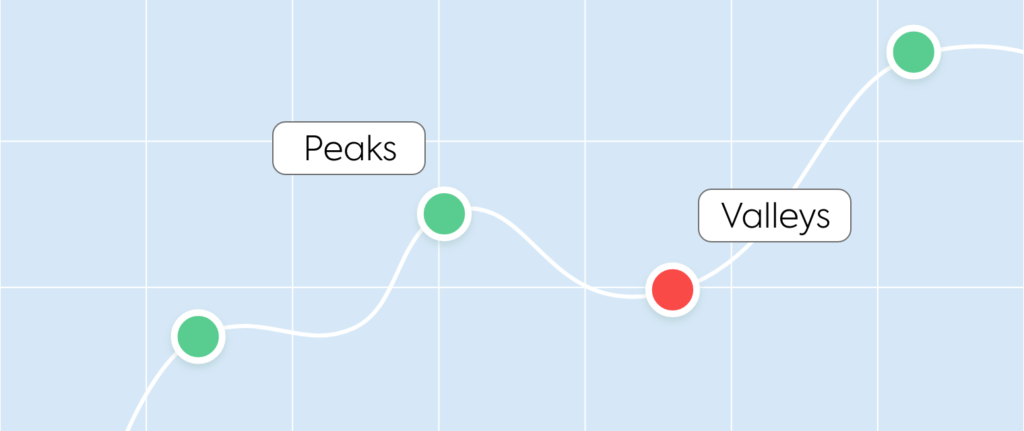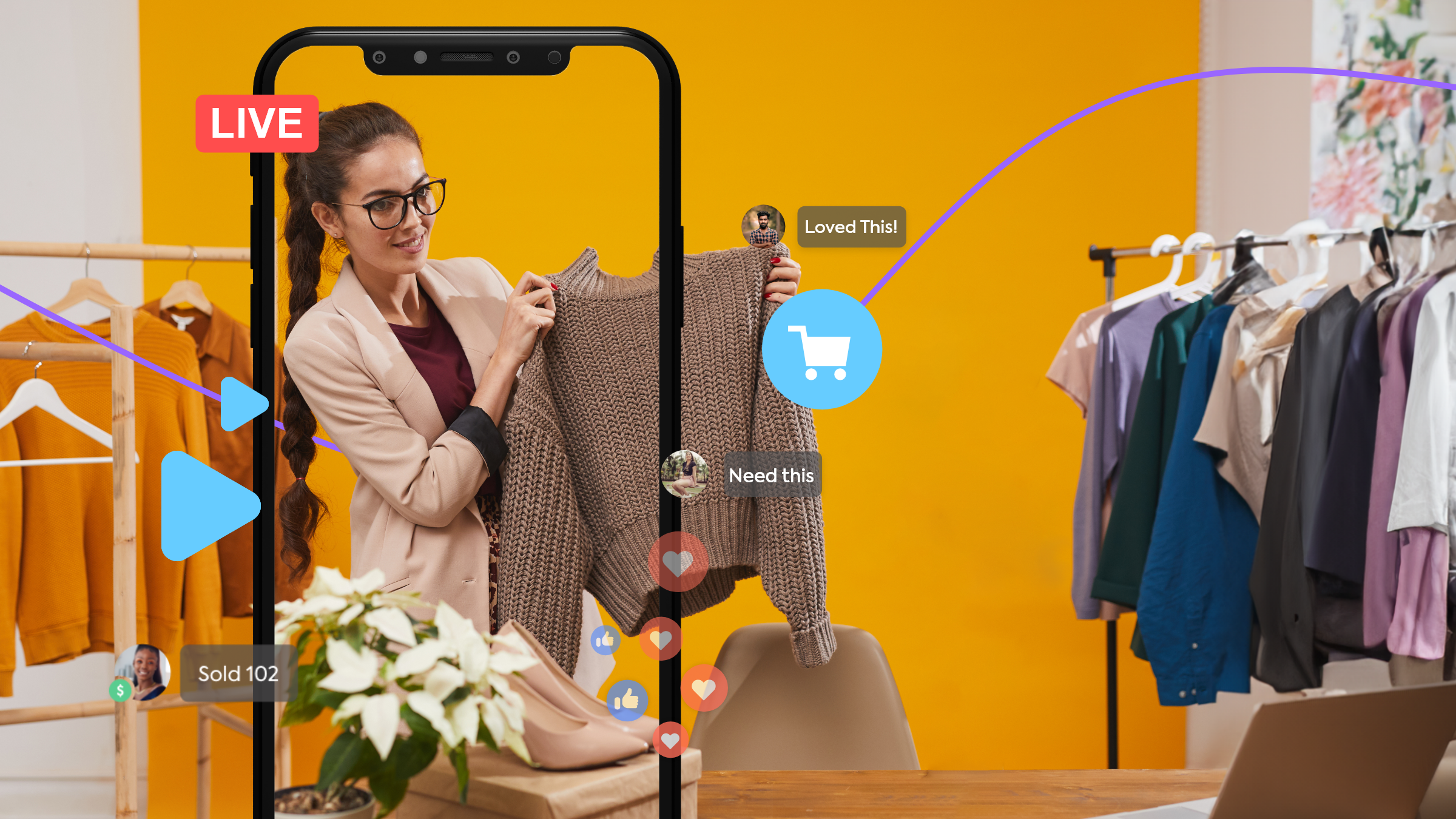Goal setting can help retailers reach the next level of their business and can be a good way to reflect on what is going well and what can be improved. When most online retailers think about creating targets and objectives for their businesses, revenue and sales goals are top of mind.
As live selling grows in popularity within the retail space, however, new milestones and benchmarks are being considered, such as live video sale viewer count and the number of social media followers a brand has. Live selling should not only be considered in your overall business strategy, but should be factored into your monthly benchmarks as well.
There’s no shortage of advice or ideas floating around to help online sellers succeed. However, considering that livestream e-commerce is forecast to generate $17 billion in the United States in 2022 alone, it’s wise to begin incorporating a live sales strategy into the mix if you haven’t done so already. If you’re a seasoned live seller, we have a few suggestions for goals you can consider to help expand your growth and increase your revenue.
Annual, monthly, weekly, and daily goals for retailers include the following categories:
- Business goals
- Revenue goals
- Sanity goals
- Live selling goals
The aforementioned categories can help you stay organized as you map out the future of the retail business and set your sights on success.
Evaluate the Past While Setting Sales Goals
Before you begin jotting down lofty goals for the future, it’s important to do some reflection to see what’s realistic and where you should be focusing your efforts moving forward. Ask yourself: What has gone well and what has underperformed? This will help you spot trends and plan ahead. Your overall goal should be to replicate what went well and avoid what went wrong.
CommentSold retailers can view reporting in their CommentSold Dashboards to take a look at their wins and losses over specific periods of time. Products that sold well could be carried over into the new year. A certain live-selling schedule or strategy that boosted sales and engagement could be replicated and built upon in the future as well.
It is also important to take a look at what didn’t sell well and cut those items or promotions from your shop going forward. We recommend setting daily, monthly, and yearly goals as far in advance as possible, not only revolving around the types of products and offers your business promotes, but also around internal business operations, like staffing and time off.
Setting Monthly Business Goals for Retail
You should be setting revenue goals for each month, whether that’s your target revenue, profit, number of items sold, or special promotions and offers you want to launch. In order to set these targets, reflection, research, and reporting are key.
At the very minimum, keep this list handy and get in the habit of keeping a record of the following:
- What went well the previous month?
- What didn’t go well?
- How can you replicate what was successful?
- How can you avoid what was unsuccessful?
By analyzing your business reports through the CommentSold Dashboard, you can spot peaks and valleys, which will help you spot trends and adjust to set and meet goals moving forward. Reflect on these dips and increases and do a little extra digging. Consider what you can do to avoid valleys and create peaks.

Follow this plan of action every month—reflect, view the highs and lows, and use that information to set goals for the following month.
Remember: Special events could drive sales and cause peaks. Low months could be the result of unforeseen personal circumstances, or industry trends like the “J-month slump,” where retail sales generally see a widespread dip in January, June, and July.
Come up with a contingency plan to quickly implement in the future to combat dips.
If one of your monthly goals is to buy new inventory, or plan for the upcoming season, use reporting to view your most popular items and aim to purchase similar products. Through reporting, you can view your sell-through items to see which products sat on the shelf for a long time, compared to those that sold out quickly.
After viewing this reporting, ask yourself:
- Can my marketing efforts be improved for items that haven’t sold?
- Are the less popular items of poorer quality than my most popular items?
- Does my target customer really want the items that didn’t sell well?
These questions can help you develop purchasing goals and come up with special campaigns, offers, and discounts next month to help move some of your aging inventory or least popular products. Take the information and observations quickly available through reporting to reference in months ahead to strategically inform your decision-making moving forward.
If certain items didn’t sell well, and your goal for the future is to better market these items, consider refreshing them with new styling in a future live sale. You could even bring in models of different body types or demographics to show off the possibility of a less desirable item that may look better on a human than in a photo.
Creating Financial Goals
It’s important for online sellers to set attainable revenue goals. Hitting big numbers can be daunting, so we recommend breaking big, annual sales numbers into smaller steps to work toward. That way, you can hit your big goal, eventually, by hitting smaller goals along the way.
Retailers can start this process by doing the following:
- Decide on a big yearly revenue or profit goal.
- Break this number down into monthly goals.
- Once your monthly goals are set, break those down by week.
- Break your weekly goals down into daily goals.
- Evaluate trends when setting your revenue, sales, and profit goals.
Remember: Every month is not the same, so take a look at your monthly revenue from the previous year to decide which months you know will be lean and plan accordingly. Breaking down your yearly and monthly goals into weekly and daily milestones will help keep you motivated to stay on track, and you can monitor on a more frequent basis to adjust as needed in real-time.
Remember to evaluate trends when setting goals as well. While revenue might have been booming one month (due to an increase in holiday shopping, for example) that might not be your average monthly revenue in any given month. Make sure you start with an accurate picture of your business before you begin setting future goals.
Steps to determining your financial goals:
- Ask yourself: How much do I want to earn in a year?
Figure this out early in the year, if possible, and view your year-over-year (June 2022 – June 2023, for example) profits. - Determine how much you want to sell.
Factor in all of your business expenses (e.g. rent, marketing costs) and how much product you need to sell to reach your desired net income. - Break your revenue goal down into smaller goals.
As mentioned previously, come up with your 12-month “number” (step one) and divide that number by 12 to get your monthly revenue goal.
*To find your daily sales goal number, divide the monthly goal amount by the number of days in that month. Divide by the number of weeks in the month for the weekly goal. Look at patterns in previous years to see if these smaller goals are realistic for your business. - Create and implement your plan
This takes action, discipline, and consistency. What inventory should you showcase to hit your goals? Implement this plan on a weekly basis. You should be on track to hit, if not exceed, your “big goal” by the 12-month mark if you stay on track and make adjustments as needed.

Setting Your Sanity Goals
Making money is not the only goal you should have for your business. Your mental health and overall wellbeing are just as important. It’s crucial to develop goals, benchmarks, and milestones surrounding your sanity to make sure your business runs smoothly and you feel good about the direction your business is heading.
Sit down with your team to highlight the biggest logistical inefficiencies or pain points your business is facing, and choose one or two to tackle this year. Whether it is streamlining fulfillment with FlexLabels or planning a long weekend away during peak season, setting your top sanity goals will keep your team focused—and pay huge dividends throughout the year.
A vacation could absolutely be a goal! Account for a small financial dip during this time so you don’t get discouraged. Come up with a plan to keep the ball rolling even if you are short-staffed or cannot be present to handle situations as they arise.
Live selling can help boost revenue goals, but it can also contribute to “sanity goals.”
For example, if unforeseen circumstances occur and you have to temporarily shut the doors to your brick-and-mortar business, live selling is a great way to continue providing a personalized shopping experience to customers virtually.
If your main live sale host is ill or needs to take time off work, set a goal to incorporate influencers or models of different body types in your live sales. Not only is this a great backup plan, it’s also a way to capture new audiences and make consumers of all demographics feel included and considered.
Consider setting goals around easing your workload as well. With automation features becoming more prevalent for online retailers, factor in the cost, time it takes to learn a new platform, and amount of time you could save by automating processes like invoicing, marketing communications, or posting on social media.
100% of retailers live selling with CommentSold said they gained more free time and productivity with the platform’s automation features.
Live Selling Goals
As you begin creating business goals for retail and setting sales goals, remember to think about your live-selling strategy as well. It may be easiest to break your live-selling goals into smaller “chunks” since live selling should be part of your overall sales strategy.
Start with your benchmarks and work backward to determine how often you want to live sell and how many items you’ll sell during the live. This can also help inform which types of products you sell (e.g. aging inventory, popular items, or new items).
Here are a few considerations when setting your live sales goals:
- Aim for regular live sales. Work up to once a day if you have enough inventory. Above all, make sure you are going live on a consistent schedule so your audience knows when to tune in. If you can only go live once a week, that is fine! Successful live sellers go live for at least one hour and showcase several different looks.
- Come up with a schedule. Determine how many days a week, and which days, you plan to sell. This should be a goal, and putting steps in place to promote the sale and communicate to your shoppers should be part of the planning phase. Make sure you tease upcoming live sales across social media or in an email blast a week before, the day before, and an hour before you go live!
- Decide how many pieces you’ll show during your live sale. If you’re looking for an easy way to meet revenue goals, consider upselling during your live sale by pairing an expensive item with a lower-priced product and to sell shoppers on the complete look.
- Project potential revenue if all items are sold. Factor in the average cost of each item and what you could possibly make if all items sell out during the live sale. Your goal may be to sell out of everything, but depending on the realistic scope of your business, the goal could be smaller or more specific.
The Takeaway
Share your big-picture goals with someone you trust to keep you accountable. This would be great to share with your mentor, another boutique owner, or even your teammates. Having other people that can keep you accountable for your goals will increase the chance of you hitting them. Remember to break larger goals into smaller “chunks” or milestones you can consistently strive to reach along the way. Use live selling to help you meet your revenue goals, and develop creative ways to enhance your live sales so each broadcast is a success.



